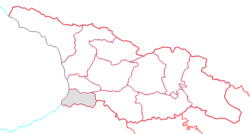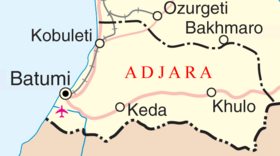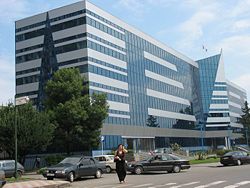Adjara
| Autonomous Republic of Adjara
აჭარის ავტონომიური რესპუბლიკა
Ach'aris Avt'onomiuri Resp'ublik'a |
||||||
|---|---|---|---|---|---|---|
|
||||||
 Ajaria (gray) within Georgia
|
||||||
 Detailed map of Adjara
|
||||||
| Capital | Batumi | |||||
| Official languages | Georgian | |||||
| Ethnic groups (2002) | 93.4% Georgians 2.4% Russians 2.3% Armenians 0.6% Greeks 0.4% Abkhazians 0.2% Ukrainians 0.2% others |
|||||
| Government | ||||||
| - | Chairman of the Government |
Levan Varshalomidze |
||||
| Autonomous republic | ||||||
| - | Part of unified Georgian Kingdom |
9th century |
||||
| - | Conquered by Ottoman Empire |
1614 |
||||
| - | Ceded to Russian Empire | 1878 | ||||
| - | Adjar ASSR | 1921 | ||||
| - | Autonomous republic of Georgia |
1991 |
||||
| Area | ||||||
| - | Total | 2,900 km2 1,120 sq mi |
||||
| - | Water (%) | negligible | ||||
| Population | ||||||
| - | 2002 census | 376,016 | ||||
| - | Density | 135.32/km2 350.5/sq mi |
||||
| Currency | Georgian lari (GEL) |
|||||
| Time zone | MSK (UTC+3) | |||||
Adjara (Georgian: აჭარა — ach'ara), officially the Autonomous Republic of Adjara (აჭარის ავტონომიური რესპუბლიკა — ach'aris avt'onomiuri resp'ublik'a), is an autonomous republic of Georgia. Adjara is also spelt Ajara or Adzhara, and is also known as Ajaria/Adjaria/Adzharia, or as Achara. Adjara is located in the southwestern corner of Georgia, bordered by Turkey to the south and the eastern end of the Black Sea. Adjara is the region identified with the Adjar ethnic group.
Formerly Adjara was known as Acara under the Ottoman rule and Adjarian Autonomous Soviet Socialist Republic (Adjar ASSR) under the Soviet Union.
Contents |
History
Adjara has been part of Colchis and Caucasian Iberia since ancient times. Colonized by Greeks in the 5th century BC, the region fell under Rome in the 2nd century BC. It became part of the region of Egrisi before being incorporated into the unified Georgian Kingdom in the 9th century AD. The Ottomans conquered the area in 1614. The people of Adjara converted to Islam in this period. The Ottomans were forced to cede Ajaria to the expanding Russian Empire in 1878.
After a temporary occupation by Turkish and British troops in 1918–1920, Ajaria became part of the Democratic Republic of Georgia in 1920. After a brief military conflict in March 1921, Ankara's government ceded the territory to Georgia due to Article VI of Treaty of Kars on condition that autonomy is provided for the Muslim population. The Soviet Union established the Adjar Autonomous Soviet Socialist Republic in 1921 in accord with this clause. Thus, Adjara was still a component part of Georgia, but with considerable local autonomy.
After the dissolution of the Soviet Union in 1991, Ajaria became part of a newly independent but politically divided Republic of Georgia. It avoided being dragged into the chaos and civil war that afflicted the rest of the country between 1991–1993 due largely to the authoritarian rule of its leader Aslan Abashidze. Although he successfully maintained order in Adjara and made it one of the country's most prosperous regions, he was accused of involvement in organised crime – notably large-scale smuggling to fund his government and enrich himself personally – as well as human rights violations. The central government in Tbilisi had very little say in what went on in Adjara; during the presidency of Eduard Shevardnadze, it seemed convenient to turn a blind eye to events in Adjara.
This changed following the Rose Revolution of 2003 when Shevardnadze was deposed in favour of the reformist opposition leader Mikheil Saakashvili, who pledged to crack down on separatism within Georgia. In the spring of 2004, a major crisis in Ajaria erupted as the central government sought to reimpose its authority on the region. It threatened to develop into an armed confrontation. However, Saakashvili's ultimatums and mass protests against Abashidze's autocratic rule forced the Adjaran leader to resign in May 2004, following which he went into exile in Russia. After Abashidze's ousting, a new law was introduced to redefine the terms of Ajaria's autonomy.
For many years, Russia maintained the 12th Military Base (the former 145th Motor Rifle Division) in Batumi.[1] This was a source of great tension with Georgia, which had threatened to block access to the facility. Following talks in March 2005, the Russian government proposed to begin the process of withdrawal later the same year; Russia returned the base to Georgia on November 17, 2007, more than a year ahead of schedule.
In July 2007, the seat of the Georgian Constitutional Court was moved from Tbilisi to Batumi.[1]
Law and government
The status of the Ajarian Autonomous Republic is defined by Georgia's law on Ajaria and the region's new constitution, adopted following the ousting of Aslan Abashidze. The local legislative body, Supreme Council (parliament) of Adjara consists of 30 members and is elected for four years. The head of the region's government – the Council of Ministers of Adjara is nominated by the President of Georgia who also has powers to dissolve the assembly and government and to overrule local authorities on issues where the constitution of Georgia is contravened. Levan Varshalomidze is the current head of the Adjaran government.
Adjara is subdivided into six administrative units:
- City of Batumi
- District of Keda
- District of Kobuleti
- District of Khelvachauri
- District of Shuakhevi
- District of Khulo
Geography and climate
Adjara is located on the south-eastern coast of the Black Sea and extends into the wooded foothills and mountains of the Lesser Caucasus. It has borders with the region of Guria to the north, Samtskhe-Javakheti to the east and Turkey to the south. Most of Ajaria's territory either consists of hills or mountains. The highest mountains rise more than 3,000 meters (9,840 ft) above sea level. Around 60% of Ajaria is covered by forests. Many parts of the Meskheti Range (the west-facing slopes) are covered by temperate rain forests.
Climate


Adjara is well-known for its humid climate (especially along the coastal regions) and prolonged rainy weather, although there is plentiful sunshine during the Spring and Summer months. Ajaria receives the highest amounts of precipitation both in Georgia and in the Caucasus. It is also one of the wettest temperate regions in the northern hemisphere. No region along Adjara's coast receives less than 2,200mm (86.6 inches) of precipitation per year. The west-facing (windward) slopes of the Meskheti Range receive upwards of 4,500mm (177 inches) of precipitation per year. The coastal lowlands receive most of the precipitation in the form of rain (due to the area's subtropical climate). September and October are usually the wettest months. Batumi's average monthly rainfall for the month of September is 410mm (16.14 inches). The interior parts of Adjara are considerably drier than the coastal mountains and lowlands. Winter usually brings significant snowfall to the higher regions of Ajaria, where snowfall often reaches several meters. Average summer temperatures are between 22-24 degrees Celsius in the lowland areas and 17-21 degrees Celsius in the highlands. The highest areas of Ajaria have lower temperatures. Average winter temperatures are between 4-6 degrees Celsius along the coast while the interior areas and mountains average around -3-2 degrees Celsius. Some of the highest mountains of Ajaria have average winter temperatures of -8-(-7) degrees Celsius.
Economy
Adjara has good land for growing tea, citrus fruits and tobacco. Mountainous and forested, the region has a subtropical climate, and there are many health resorts. Tobacco, tea, citrus fruits, and avocados are leading crops; livestock raising is also important. Industries include tea packing, tobacco processing, fruit and fish canning, oil refining, and shipbuilding.
The regional capital, Batumi, is an important gateway for the shipment of goods heading into Georgia, Azerbaijan and landlocked Armenia. The port of Batumi is used for the shipment of oil from Kazakhstan and Turkmenistan. Its oil refinery handles Caspian oil from Azerbaijan which arrives by pipeline to Supsa port and is transported from there to Batumi by rail. The Ajarian capital is a centre for shipbuilding and manufacturing.
Adjara is the main center of Georgia's coastal tourism industry, having displaced the northwestern province of Abkhazia since that region's de facto secession from Georgia in 1993.
Population

According to the 2002 census, the population of Adjara is 376,016. The Adjarians (Ajars) are an ethnographic group of the Georgian people who speak a group of local dialects known collectively as Adjaran. The written language is Georgian.
The Georgian population of Adjara had been generally known as "Muslim Georgians" until the 1926 Soviet census which listed them as "Ajars" and counted 71,000 of them. Later, they were simply classified under a broader category of Georgians as no official Soviet census asked about religion. Today, calling them "Muslim Georgians" would be a misnomer in any case as Adjarans are now about half Christian (see below).
Ethnic minorities include Laz, Russians, Armenians, Greeks, Abkhaz, etc.[2]
Religion
The collapse of the Soviet Union and the re-establishment of Georgia's independence accelerated re-Christianisation, especially among the young,[3] a process allegedly encouraged by the governmental officials. However, there are still remaining Sunni Muslim communities in Adjara, mainly in the Khulo district. According to the 2006 estimates by the Department of Statistics of Adjara, 63% are Georgian Orthodox Christians, and 30% Muslim,[2] while according to the BBC, "nowadays about half the population professes the Islamic faith".[4] The remaining are Armenian Christians (0.8%), Roman Catholics (0.2%), and others (6%).[2]
Famous Ajarians

- Memed Abashidze (1873-1941), a prominent political leader of Muslim Georgians
- Aslan Abashidze (b. 1938), an ousted regional leader
- Tbeli Abuserisdze (1190-1240), a Georgian writer and scientist
- Zurab Nogaideli (b. 1964 ), former Prime Minister of Georgia (3 February 2005 - 16 November 2007)
- Levan Varshalomidze (b. 1973), current regional leader
See also
- Subdivisions of Georgia
- Former countries in Europe after 1815
References
- ↑ Note that the promises made at the 1999 Istanbul OSCE conference were in regard to withdrawal of Russian forces from Vaziani, near Tbilisi, and Gudauta. See also Transcaucasus Group of Forces
- ↑ 2.0 2.1 2.2 (Georgian)Autonomous Republic of Adjara, Department of Statistics
- ↑ George Sanikidze and Edward W. Walker (2004), Islam and Islamic Practices in Georgia. Berkeley Program in Soviet and Post-Soviet Studies. University of California, Berkeley Institute of Slavic, East European, and Eurasian Studies.
- ↑ BBC NEWS | World | Europe | Country profiles | Regions and territories: Ajaria
External links
- Government of Adjara
- Supreme Council of Adjara
- Tourist Department of Adjara
- Adjara portal
- Georgian territories: Ajaria - BBC profile
- Images of Ajaria
- Islam and Islamic Practices in Georgia
- In pictures: Ajaria's 'velvet revolution' 2004
- The Guide to Adjara
|
|||||||||||||||||
|
|||||||

